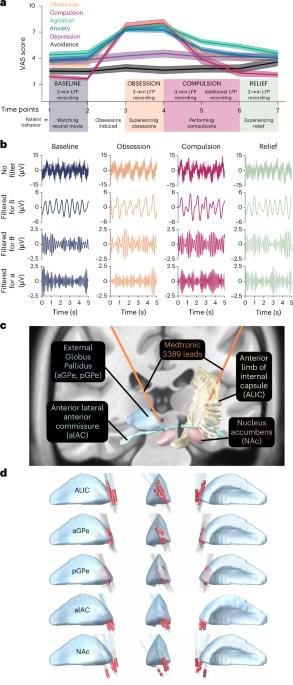Intracranial electrophysiological biomarkers of compulsivity in obsessive–compulsive disorder
IF 8.7
引用次数: 0
Abstract
There is an emerging need for objective neural biomarkers of obsessive–compulsive disorder (OCD) to improve the efficacy of neuromodulatory interventions, most notably deep-brain stimulation (DBS), and develop closed-loop stimulation paradigms. Preliminary data suggest that such biomarkers may be derived from local field potentials (LFPs) recorded in individual patients implanted with sensing DBS devices. However, reliable LFP signatures that are generalizable across OCD patients have yet to be identified. Here, we relate LFPs recorded from sensing DBS electrodes in different basal-ganglia structures to core symptoms of OCD in 11 patients during personalized provocation of obsessions and compulsions. We identify two general markers of compulsion: delta and alpha LFP power was significantly increased during all compulsions in the external globus pallidus (GPe), nucleus accumbens, anterior limb of the internal capsule (ALIC) and anterior lateral anterior commissure. In mental compulsion subtypes, similar low-frequency increases were observed only in GPe (delta/alpha) and ALIC (alpha), suggesting that these signals possibly reflect more universal biomarkers of compulsivity unconfounded by motor function. GPe delta power correlated with OCD symptom severity, establishing a meaningful connection between subcortical sensing DBS readout and patient experience. ALIC alpha power was modulated by the phase of theta oscillations during compulsions, possibly reflecting pathological coupling of cortical networks in OCD. Our results demonstrate unique, group-level LFP correlates of core OCD symptoms across disease-relevant basal-ganglia structures. These electrophysiological signatures help pave the way toward the development of biomarker-targeted neuromodulatory intervention for OCD. Netherlands Trial Register ID: NL7486 . This research identifies local field potential markers associated with obsessive–compulsive disorder symptoms in patients during provocation. Key findings reveal increased delta and alpha power in specific brain regions, correlating with symptom severity and suggesting potential biomarkers for targeted interventions.

强迫症患者强迫性的颅内电生理生物标志物
目前,强迫症(OCD)需要客观的神经生物标志物来提高神经调节干预的效果,尤其是深部脑刺激(DBS),并建立闭环刺激范式。初步数据表明,这些生物标志物可能来自植入感应DBS装置的个体患者记录的局部场电位(lfp)。然而,可靠的LFP特征在强迫症患者中普遍存在,尚未被确定。在这里,我们将11名患者在个性化的强迫和强迫刺激下,通过感应基底神经节不同结构的DBS电极记录的lfp与强迫症的核心症状联系起来。我们确定了强迫的两个一般标记:在所有强迫中,苍白球外球(GPe)、伏隔核、内囊前肢(ALIC)和前外侧前联合的δ和α LFP功率显著增加。在精神强迫亚型中,类似的低频增加仅在GPe (δ / α)和ALIC (α)中观察到,这表明这些信号可能反映了与运动功能无关的更普遍的强迫生物标志物。GPe δ功率与强迫症症状严重程度相关,在皮层下感应DBS读数与患者体验之间建立了有意义的联系。强迫时ALIC的α功率受到θ波振荡相位的调节,这可能反映了强迫症中皮层网络的病理耦合。我们的研究结果表明,在与疾病相关的基底神经节结构中,核心强迫症症状具有独特的、群体水平的LFP相关性。这些电生理特征有助于为强迫症的生物标志物靶向神经调节干预的发展铺平道路。荷兰试验注册ID: NL7486。本研究确定了局部场电位标记与强迫症患者在挑衅期间的症状相关。主要研究结果显示,特定大脑区域的δ和α能量增加,与症状严重程度相关,并提示有针对性干预的潜在生物标志物。
本文章由计算机程序翻译,如有差异,请以英文原文为准。
求助全文
约1分钟内获得全文
求助全文

 求助内容:
求助内容: 应助结果提醒方式:
应助结果提醒方式:


